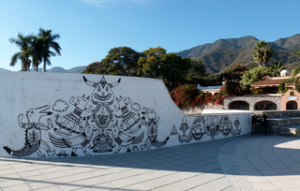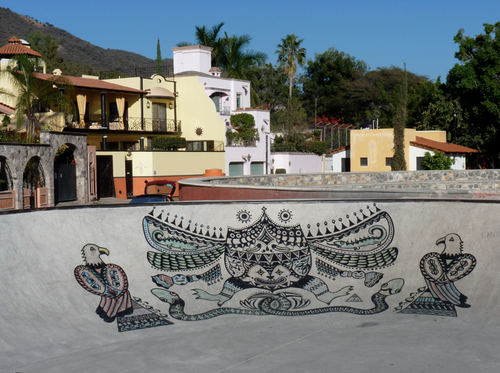How did the natural surroundings and lush colors of Mexico influence your work?
Most of the buildings in big cities tend to have sober colors. Here, homeowners could freely express their creativity and choose a wide range of colors that illuminated the streets. I loved the combination of vivid colors on the homes and gardens contrasted with the dusty streets and bright blue sky. As a result of this influence, I decided use color for my first wall instead of just black and white.

Some artists come to a residency with a particular creative game plan. Others just arrive open to whatever inspires them at the moment. How did you approach your residency and how did your studio time compare to what you anticipated?
Although I had a desire to paint a wall, I was open to whatever possibilities emerged. Luckily I already had permission to paint the wall of one of the residency houses before I arrived Mexico. In the end I painted outside most of the time, but I also spent time in my studio sketching, doing yoga, and writing in my diary at night.
What else can you share about your residency experience? Were there any surprises?
 Although Mexico is a developing country, I never had a bad experience in Chapala. People are very kind and educated. I had such a rich time and am so grateful to have experienced life in Mexico.
Although Mexico is a developing country, I never had a bad experience in Chapala. People are very kind and educated. I had such a rich time and am so grateful to have experienced life in Mexico.
 How did you structure your time during your artist residency?
How did you structure your time during your artist residency?

 I’ve been working as an illustrator in Berlin. Most of my works have been done on paper or screen. In 2012 I had chance to work on my first mural and I found it was challenging to paint large scale and develop new style of my art at the same time.
I’ve been working as an illustrator in Berlin. Most of my works have been done on paper or screen. In 2012 I had chance to work on my first mural and I found it was challenging to paint large scale and develop new style of my art at the same time. You haven’t been to North America before. Tell us about how you found your way around Chapala and explored the region.
You haven’t been to North America before. Tell us about how you found your way around Chapala and explored the region. I have been studying patterns in nature and tribal arts. I visited the National Anthropology Museum in Mexico City and Regional museums in Guadalajara where lots of art objects captured my attention. Through them I learned about the historical background, spiritual messages, and deeper meaning of primitive crafts. The imagery of my murals grew out of this study and the influence of the world around me in Chapala.
I have been studying patterns in nature and tribal arts. I visited the National Anthropology Museum in Mexico City and Regional museums in Guadalajara where lots of art objects captured my attention. Through them I learned about the historical background, spiritual messages, and deeper meaning of primitive crafts. The imagery of my murals grew out of this study and the influence of the world around me in Chapala. During the artist residency in Berlin, I lived and worked with ten artists for three months. We had weekly programs and frequent deadlines to prepare presentations. There were always other people around to discuss or share my ideas.
During the artist residency in Berlin, I lived and worked with ten artists for three months. We had weekly programs and frequent deadlines to prepare presentations. There were always other people around to discuss or share my ideas. The first mural was located near the Chapala Malecon, which is a very busy street in a residential area. During the seven days I was working on the wall, I spoke to neighbors, parking workers, garbage collectors and the roaming Mariachi bands. Day by day I felt more involved in the local culture, and even learned some Spanish. During production, I met a Mexican man who introduced me to people at the Chapala city hall who paved the way to approving the second mural.
The first mural was located near the Chapala Malecon, which is a very busy street in a residential area. During the seven days I was working on the wall, I spoke to neighbors, parking workers, garbage collectors and the roaming Mariachi bands. Day by day I felt more involved in the local culture, and even learned some Spanish. During production, I met a Mexican man who introduced me to people at the Chapala city hall who paved the way to approving the second mural. As a Japanese, I learned many differences between our cultures. People in Mexico have more freedom than in other cities or countries. If I could speak Spanish, I would have had more of a chance to communicate with the local kids who enjoyed watching me while I was painting on the wall. One of the important things I realized during the residency was a heightened awareness about the connection between humans and nature. Being at the 360 Xochi Quetzal residency was definitely valuable and will lead to the next step for my art practice.
As a Japanese, I learned many differences between our cultures. People in Mexico have more freedom than in other cities or countries. If I could speak Spanish, I would have had more of a chance to communicate with the local kids who enjoyed watching me while I was painting on the wall. One of the important things I realized during the residency was a heightened awareness about the connection between humans and nature. Being at the 360 Xochi Quetzal residency was definitely valuable and will lead to the next step for my art practice.

 Although Mexico is a developing country, I never had a bad experience in Chapala. People are very kind and educated. I had such a rich time and am so grateful to have experienced life in Mexico.
Although Mexico is a developing country, I never had a bad experience in Chapala. People are very kind and educated. I had such a rich time and am so grateful to have experienced life in Mexico.